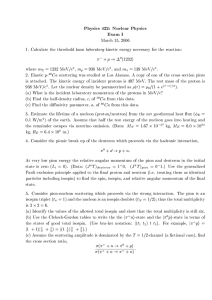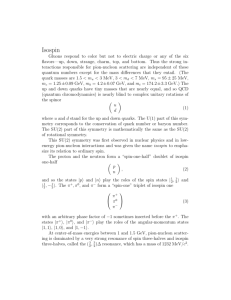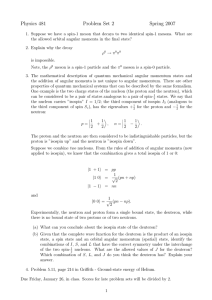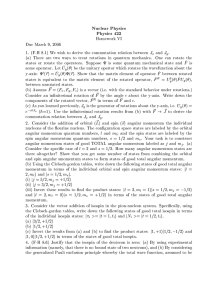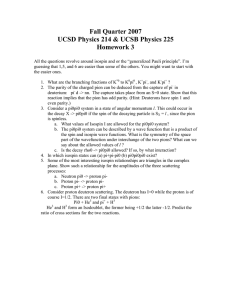Physics 422: Nuclear Physics Exam I: KEY March 15, 2006
advertisement
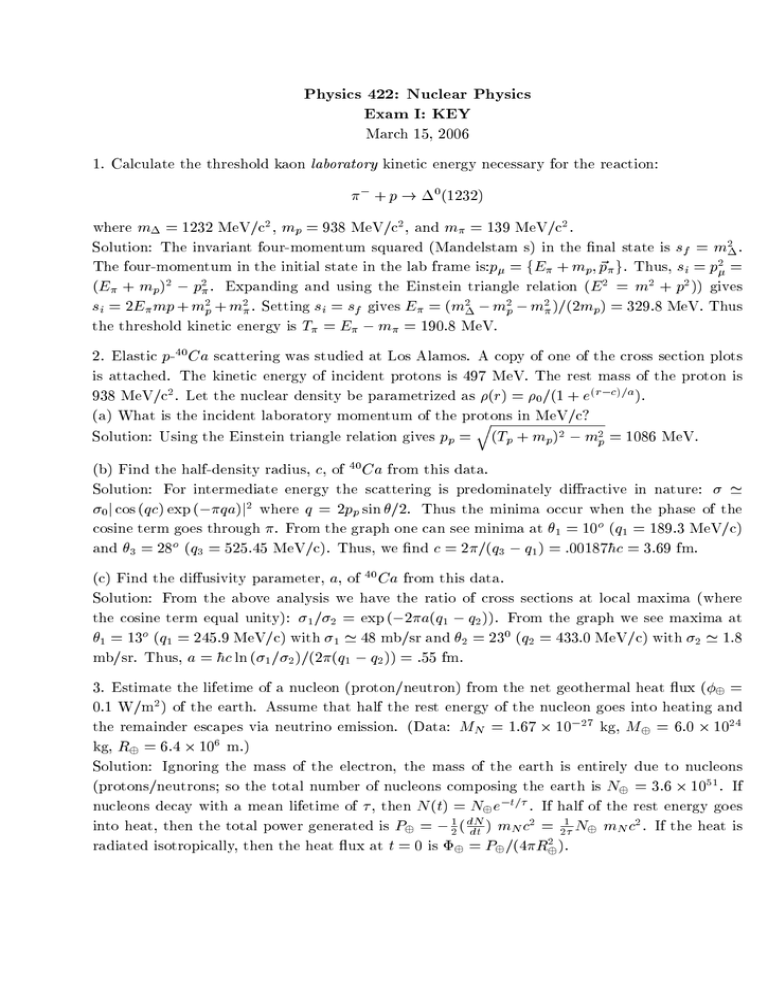
Physics 422: Nuclear Physics Exam I: KEY March 15, 2006 1. Calculate the threshold kaon laboratory kinetic energy necessary for the reaction: + p ! 0 (1232) where m = 1232 MeV/c2, mp = 938 MeV/c2, and m = 139 MeV/c2. Solution: The invariant four-momentum squared (Mandelstam s) in the nal state is sf = m2 . The four-momentum in the initial state in the lab frame is:p = fE + mp; p~ g. Thus, si = p2 = (E + mp)2 p2 . Expanding and using the Einstein triangle relation (E 2 = m2 + p2)) gives si = 2E mp + m2p + m2 . Setting si = sf gives E = (m2 m2p m2 )=(2mp ) = 329:8 MeV. Thus the threshold kinetic energy is T = E m = 190:8 MeV. 2. Elastic p-40Ca scattering was studied at Los Alamos. A copy of one of the cross section plots is attached. The kinetic energy of incident protons is 497 MeV. The rest mass of the proton is 938 MeV/c2 . Let the nuclear density be parametrized as (r) = 0 =(1 + e(r c)=a). (a) What is the incident laboratory momentum of the protons q in MeV/c? Solution: Using the Einstein triangle relation gives pp = (Tp + mp)2 m2p = 1086 MeV. (b) Find the half-density radius, c, of 40Ca from this data. Solution: For intermediate energy the scattering is predominately diractive in nature: ' 0 j cos (qc) exp( qa)j2 where q = 2pp sin =2. Thus the minima occur when the phase of the cosine term goes through . From the graph one can see minima at 1 = 10o (q1 = 189:3 MeV/c) and 3 = 28o (q3 = 525:45 MeV/c). Thus, we nd c = 2=(q3 q1) = :00187hc = 3:69 fm. (c) Find the diusivity parameter, a, of 40Ca from this data. Solution: From the above analysis we have the ratio of cross sections at local maxima (where the cosine term equal unity): 1 =2 = exp ( 2a(q1 q2 )). From the graph we see maxima at 1 = 13o (q1 = 245:9 MeV/c) with 1 ' 48 mb/sr and 2 = 230 (q2 = 433:0 MeV/c) with 2 ' 1:8 mb/sr. Thus, a = h c ln (1 =2)=(2(q1 q2)) = :55 fm. 3. Estimate the lifetime of a nucleon (proton/neutron) from the net geothermal heat ux ( = 0:1 W/m2) of the earth. Assume that half the rest energy of the nucleon goes into heating and the remainder escapes via neutrino emission. (Data: MN = 1:67 10 27 kg, M = 6:0 1024 kg, R = 6:4 106 m.) Solution: Ignoring the mass of the electron, the mass of the earth is entirely due to nucleons (protons/neutrons; so the total number of nucleons composing the earth is N = 3:6 1051. If nucleons decay with a mean lifetime of , then N (t) = N e t= . If half of the rest energy goes 2 1 2 into heat, then the total power generated is P = 21 ( dN dt ) mN c = 2 N mN c . If the heat is radiated isotropically, then the heat ux at t = 0 is = P =(4R2 ). Thus, = (NmN c2 )=(8 R2 ) = 5:25 1027 s= 1:66 1020 y. 4. Consider the pionic break up of the deuteron which proceeds via the hadronic interaction, 0 + d ! p + n: At very low pion energy the relative angular momentum of the pion and deuteron in the initial state is zero (Li = 0). (Data: (J T )deuteron = 1+0; (J T )pion = 0 1.) Use the generalized Pauli exclusion principle applied to the nal proton and neutron (i.e. treating them as identical particles including isospin) to nd the spin, isospin, and relative angular momentum of the nal state. Solution: The initial state has total angular momentum 1 (deuteron has spin 1), parity (-1) (pion is a pseudoscalar), and isospin 1. The hadronic interaction conserves all these quantities. Treat the nal state as a product of space state times spin state times isospin state. The parity and permutation properties of the space state are determined by the relative angular momentum: ( 1)L . Since the initial state is isovector (t = 1) then the nal isospin must also be t = 1. Recall that the triplet states are symmetric with respect to permutation of particle labels. Thus the generalized Pauli principle requires that the space times spin state must be antisymmetric. Consider the possible cases: 1.3S1 (L = 0 and s = 1): Both of these are permutation symmetric; so this case is Pauli forbidden. 2.1P1 (L = 1 and s = 0): The singlet state is antisymmetric and so is the orbital angular momentum state, thus this combinationis net symmetric and is Pauli forbidden. 3. 3P1 (L = 1 and s = 1): The triplet state is permutation symmetric which when multiplied by the antisymmetric L = 1 state leads to a permutation antisymmetric state which is allowed. 4. 3 D1 (L = 2 and s = 1): Both of these are permutation symmetric and so this case is Pauli forbidden. Since no other orbital angular momentum values can be combined with the spin to give a total angular momentum of one, all cases are exhausted. By permutation considerations, the only possible allowed case is 3P1 (case 3.). 5. Consider pion-nucleon scattering which proceeds via the strong interaction. The pion is an isospin triplet (t = 1) and the nucleon is an isospin doublet (tN = 1=2); thus the total multiplicity is 3 2 = 6. (a) Identify the values of the allowed total isospin and show that the total multiplicity is still six. Solution: Adding isospin one to isospin 1/2 can result in a total isospin of 3/2 (stretched state) or 1/2 (jack-knife state). Thus the total multiplicity is (2 23 + 1) + (2 12 + 1) = 4 + 2 = 6. (b) Use the Clebsch-Gordon tables to write the the j+ ni-state and the j0pi-state in terms of the states of good total isospin. (Use bra-ket notation: j(t1 t2 ) t t3i. For example, j+pi = j1 + 1ij 12 + 12 i = j(1 12 ) 23 + 32 i.) Solution: From the CG-Tables: j + ni = r1 3 1 r2 1 1 3 j2 2i + 3 j2 2i r2 3 1 r1 1 1 j0 pi = 3 j 2 2 i 3 j2 2i (c) Assume the scattering amplitude is dominated by the T = 1=2-channel (a ctional case), nd the cross section ratio, ( + + n ! 0 + p) : ( + + n ! + + n) Solution: Since the hadronic interaction conserves isospin only transitions between the same values of isospin are allowed (e.g. 23 ! 23 or 12 ! 12 ). By assumption, we may neglect the rst case. Thus, 2 1 1 jH j 1 1 ij2 ( + + n ! 0 + p) / jh 9 22 22 4 1 1 jH j 1 1 ij2 ( + + n ! + + n) / jh 9 22 22 Thus the ratio is 1/2.
